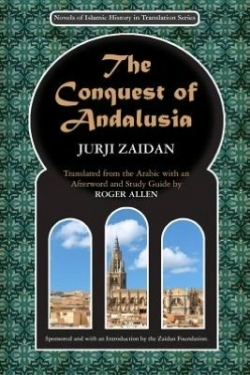The Conquest of Andalusia
Long famed in the Arab world as the father of the modern historical novel, the late Jurji Zaidan is little known in English-speaking countries. Although the Lebanese-born writer died nearly a century ago, The Zaidan Foundation believes that his twenty-two novels remain relevant today, and it is translating his works to reach English-language audiences. The Conquest of Andalusia, published in 1903, is the first effort in the foundation’s campaign. At times overly formal by contemporary standards, the novel presents a valuable look into the point of view of its author.
The Conquest of Andalusia is set during the Muslim invasion of southern Spain in the early eighth century. Zaidan focuses on political, personal, romantic, and religious intrigues in the court of the brutish and salacious Visigothic King Roderic. The object of the king’s lust is a virginal princess named Florinda. She is the fiancée of Alfonso, son of the previous king, and the daughter of the scheming Count Julian, the governor who holds Gibraltar—the gateway that guards the passage between Europe and Africa, Christian Spain, and Muslim Morocco.
Zaidan’s prose, as translated by Roger Allen, is both formal and colorful. His writing conveys both character and mood. The novel involves much posturing by king, counts, and bishops, as well as much brooding by the hero and sighing by the heroine. All this is fortunately relieved by Ya’qub, a servant-cum-sidekick of Alfonso, who becomes an important figure in the story.
Behind the melodrama, however, lies a deeper plot and a unique view of Christian Spain in the Dark Ages, with its forcibly converted Jewish minority (Ya’qub is a key member) and its feuding Roman and Gothic ethnic groups. Feeding the fire beneath this bubbling pot is Tark Ibn Ziyad, a general whose Muslim forces sweep into southern Spain at the invitation of Count Julian and others seeking foreign help in removing the king.
Zaidan uses this conflict to contrast the religiously and politically tolerant Ziyad with the oppressive Roderic, especially in regard to the Spanish Jews whom the Muslims regarded as brothers (each descended from one of Abraham’s sons). Few readers may realize that prior to the foundation of the state of Israel, Muslims, and Jews usually got along and often united in a common cause against imperial Christianity. This relationship, which Zaidan praises, is a core message in The Conquest of Andalusia.
Zaidan’s Jews are portrayed as schemers who pit Muslim and Christian, Roman and Goth, and Count and King against each other. While modern readers may squirm at this rather unflattering depiction, in Zaidan’s view they were acting out of self-defense and self-preservation. How Ya’qub manipulates the Christian nobles into battling one another is the real story here; Alfonso and Florinda are window dressing.
Zaidan’s depiction of the Dark Ages rings true. The plot is slow by modern standards, but the story has some good twists, and the characters are rich and memorable. In The Conquest of Andalusia, Zaidan’s words carry meaning for a modern world that remains caught in the dramatic struggles begun over a millennium ago.
Reviewed by
Mark G. McLaughlin
Disclosure: This article is not an endorsement, but a review. The publisher of this book provided free copies of the book and paid a small fee to have their book reviewed by a professional reviewer. Foreword Reviews and Clarion Reviews make no guarantee that the publisher will receive a positive review. Foreword Magazine, Inc. is disclosing this in accordance with the Federal Trade Commission’s 16 CFR, Part 255.

